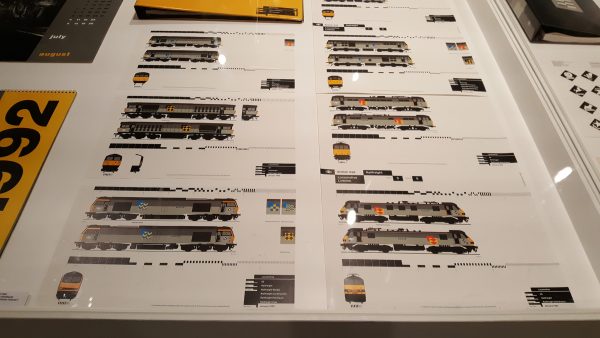Open for just four days – and closing on Monday – this is a chance to see one of the more forgotten aspects of railway design, the time when freight got an iconic makeover.
Rail freight was, and still is seen as the ugly duckling of the railways, carting dirty goods on strange looking wagons and holding up the seemingly vastly more important passenger trains. Rarely seen in daytime, they are nonetheless a curious delight when spotted in the wild, and often causing even the most smartphone addicted passenger to look up briefly as they rumble through train stations.
Railfreight was the company established in 1982 to handle British Rail’s cargo deliveries — the vital supply of coal to power stations, oil to depots, gravel to building sites. As dirty as their wares, with grey painted trains to hide the grime and save on washing, they were an unloved part of the railways.
However, even freight needs to appeal to customers, and customers were seeing a dirty unloved railway — and if you’re reliant on reliable deliveries, you don’t want to rely on what looks like an uncaring provider.
Over a few years, Railfreight turned around its operations, and it was time to tell the world.
Away with grey and dirt, and in 1987, a new brand arrived. A series of solid geometrical shapes on trains and at depots heralded a new era of pride in the industrial heart of railway logistics.
A defined look that, for a few short years, captured the attention of design fans with their easy to identify and distinctive coloured patterns. These were still industrial heavy goods trains, but a decorative tiara had been added.
The use of clear design wasn’t just about telling their corporate customers that the railways were being invested in, and hence would be a reliable supplier — but about reinvigorating the way the company worked.
Services were split into divisions, for coal, for steel, for oil, etc. Each depot was given it’s own personal sign, to create a sense of local ownership in the staff maintaining the trains.
A guide book was published, and shockingly at the time, a series of calendars made freight trains look damn sexy.
The exhibition about that moment of enlightenment shows off some of the brand guideline documents that were produced, as well as the way each locomotive was to be decorated.
Do look around the floor and columns as well, which have all been decorated with decals from the depots and division signs.
Hanging on a wall, looking not unlike it belongs in an art gallery is one of the original divisional signs.
But it was a short period of design delight — as the freight company was broken up just seven years later.
Today there are now four rail freight companies in the UK, each with a different approach to branding, and while Freightliner and GB Railfreight come closest to having some consideration for their brand identity, none of them have ever matched the iconic brand that, for a few years, adorned Railfreight’s wagons, locomotives and depots.
The exhibition, Design for Rail, is closed on Sunday, but open on Monday from 9:30am to 5:30pm at A&AD’s offices on Cheshire Street. That’s it’s last day.
Bizarre to go to all that effort to curate a display, and open it for just a few days.
There’s a small, but rather beautiful catalogue available for £10, cash only.














big shame that this exhibition is not going on a UK tour as it would have been nice to visit or been extended by say a fortnight as i would have been happy to make the trip especially to see it.
I knew nothing of this, a truly beautiful design